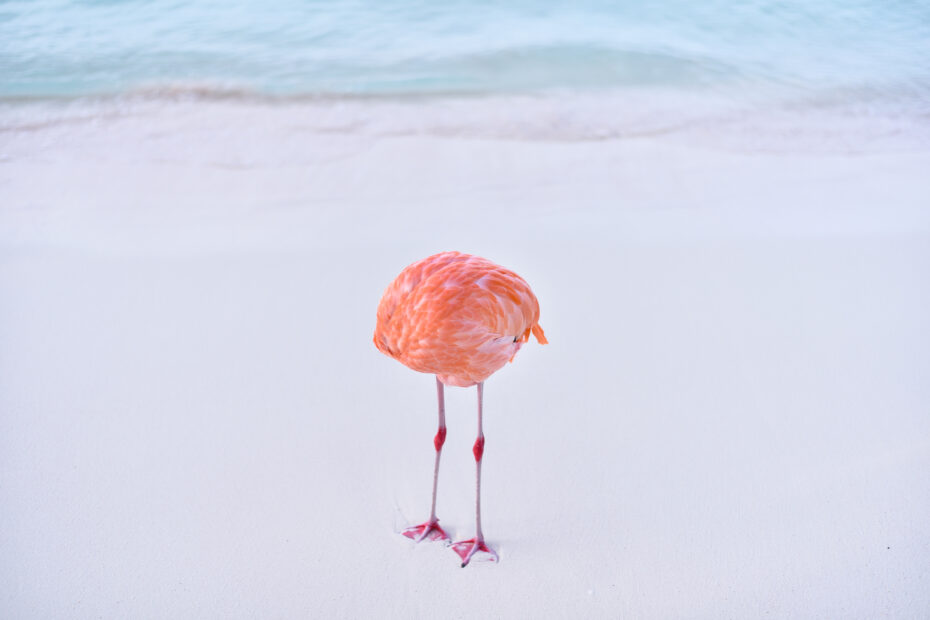An account has already been registered with this email. Please check your inbox for an authentication link to sign in.
As an independent publication, we rely on readers like you to fund our journalism and keep our reporting and criticism free and accessible to all. If you value our coverage and want to support more of it, consider becoming a member today.
In an unusual turn of events, one photographer has pushed back against AI by not only submitting, but winning a photo contest for generative images with a real photo that he took. Miles Astray’s “F L A M I N G O N E” (2022), featuring the lanky pink bird with its head hidden in its feathers as it was scratching its belly on a white-sand shore, was subsequently disqualified from the AI category of the 1839 Awards Color Photography Contest after being awarded third place by the jury and securing the people’s vote.
Sign up for our free newsletters to get the latest art news, reviews, and opinions from Hyperallergic.
“I entered this actual photo into the AI category of 1839 Awards to prove that human-made content has not lost its relevance, that Mother Nature and its human interpreters can still beat the machine, and that creativity and emotion are more than just a string of digits,” Astray wrote in a blog post.
This UNO reverse card moment comes a little over a year after German photographer Boris Eldagsen won a Sony World Photography award with his AI-generated “photo” derived from prompt engineering on DALL-E 2. Eldagsen, however, opted to refuse the award instead after disclosing to the jury panel that he had used AI.
After securing the award, Astray revealed to the team of jurors, who hold high-level imaging positions at the New York Times, Getty Images, and Phillips, among other companies, that “F L A M I N G O N E” was indeed a real photo. 1839 Awards decided to disqualify Astray’s entry — a decision the photographer says he agrees with.
“Let me start by saying we fully appreciate the powerful message Miles relayed with his submission to the AI category,” said Lily Fierman, the co-founder and director of Creative Resource Collective, the company that manages 1839 Awards among other photography contests, in an email to Hyperallergic. “We agree that it is an important, relevant, and timely statement.”
But Fierman and the team agreed that it wasn’t fair to the other contestants whose submissions abided by the rules, noting that “we understand that [his submission] was the point, but we don’t want to prevent other artists from their shot at winning in the AI category.”
There’s no hard feelings between the two parties, either, as 1839 Awards has asked Astray to write for them about this exact topic. “No one believes in the power of photography more than we do,” Fierman left off.
Recounting the experience to Hyperallergic, Astray said that “F L A M I N G O N E” was the perfect shot for hammering in the point because “the scene is so unreal and for such a simple, natural reason: a flamingo scratching its belly.”
As an independent publication, we rely on readers like you to fund our journalism and keep our reporting and criticism free and accessible to all. If you value our coverage and want to support more of it, consider becoming a member today.
Rhea Nayyar (she/her) is a New York-based teaching artist who is passionate about elevating minority perspectives within the academic and editorial spheres of the art world. Rhea received her BFA in Visual…
More by Rhea Nayyar
You must be a Member to post a comment. Sign in or become a member now.
From Niki de Saint Phalle to the subway, time is running out to see some of our favorite art in the city.
“The sense of freedom I felt in New York had nothing to do with the art world,” the painter told Hyperallergic.
The two-year project connected six visual art institutions across Europe in an innovative collaboration model.
Accompanying a show at The Met, The Art of the Literary Poster examines the commercial, artistic, and political dimensions of the late-19th-century form.
Eugene Richards’s sensitive photographs in Remembrance Garden are rooted in over 100 visits he took to the grounds after enduring COVID in 2020.
North America’s largest Japanese film festival presents two weeks of contemporary movies at Japan Society in NYC, July 10–21.
Police thwarted efforts to build a new Gaza Solidarity Encampment on the campus earlier in the week.
The new phase of the 1-800 Happy Birthday art initiative aims to raise national awareness about the “epidemic of state violence.”
Crafted from fallen timber the artist gathered in the Sierra Nevada forests, this site-specific work is set in the botanical gardens at the Los Angeles institution.
A new study challenges long-held beliefs about the physical spaces of Christian worship, proving that the emerging religion’s story is not immutable.
The Minneapolis Institute of Art and the Joslyn Art Museum also halted exhibitions in the wake of sexual assault allegations against the artist, which he denies.
Hyperallergic is a forum for serious, playful, and radical thinking about art in the world today. Founded in 2009, Hyperallergic is headquartered in Brooklyn, New York.
We’ve recently sent you an authentication link. Please, check your inbox!
Enter the code you received via email to sign in, or sign in using a password.
